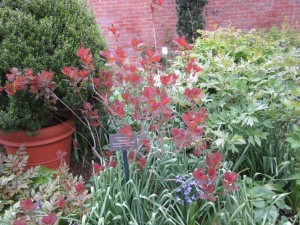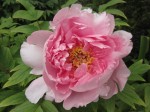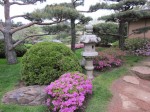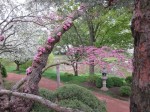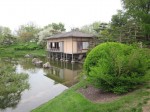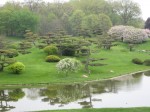Give new meaning to what is in your yard as you plant:
CHINESE MEANING & SIGNIFICANCE OF SOME TREES & PLANTS
- Acacia – stability
- Apple – feminine beauty, peace
- Apricot – fair sex, eye shape
- Azalea – fair sex
- Bamboo – filial piety, youth
- Chrysanthemum – mid-autumn, joviality, the rising sun (Japan)
- Cypress – royalty
- Jasmine – fair sex and sweetness, friendship
- Lotus – summer, fruitfulness
- Magnolia – feminine sweetness and beauty
- Mulberry – industry, the comforts of home filial piety
- Narcissus – rejuvenation, good fortune for the coming year
- Oak – masculine strength
- Oleander – beauty and grace
- Orange – presented at Chinese New Year betokens abundant happiness and prosperity for the New Year
- Orchid – love and beauty. It stands for fragrance and refinement, numerous progeny – the embodiment of the perfect or superior man, endurance
- Palm tree – happy retirement
- Peach – marriage, immortality and springtime friendship
- Pear – emblem of wise and benevolent administration or good government, longevity, justice and purity
- Peony – love and affection, symbol of feminine beauty, omen of good fortune
- Persimmon (date plum) – joy
- Pine- longevity; metaphorically, friends who remain constant in adversity
- Plum – winter, beauty and youth
- Pomegranate – posterity, numerous virtuous offspring rising to fame and glory – fertility
- Rose – beauty
- Stone – reliability and hardness
- Willow – Spring, Buddhist symbol of meekness, fair sex, waistline
Source: Chinese Symbolism and Art Motifs by C. A. S Williams
More gardening tips below.
CALENDAR
June 1st & 2nd — New Moon & Solar Midnight partial eclipse in Arctic and Canada.
June 15th — Full Moon & Lunar total eclipse – seen in Africa, the Middle East and southwestern Asia, South America and Europe, Asia and Australia, but unfortunately nobody in North America will see it.
June 19th — Father’s Day
June 21st — Summer Solstice – longest day, shortest night of the year.
July 1st — New Moon and another Solar eclipse – chances are that this eclipse will be witnessed only by penguins and sea birds but three eclipses in a month’s time is very rare.
OUR PLACE IN TIME
Eclipses happen whether we see them or not but what do they mean? What is their effect on us, if any? In astrology and feng shui, we look at new moons, full moons as having bigger influences on us than other times of the month.
- New moons are times of new beginnings.
- Full moons are times of completion, finishing and endings.
- Eclipses happen every six months and have a longer lasting effect on
us depending on where the eclipse fits into our own astrological charts
which are our individual roadmaps.
Feng Shui Gardening Tips
Now that we’ve had a good summertime weekend where it was actually fun to be outside, it’s time to take a look at using feng shui in the yard and garden.
Outside the house, direction becomes very important because that is how the light hits not only the house but the plants and trees in our yard.
COLOR: Have you noticed that shade plants are often in the blues (delphiniums, lobelia, etc.) and darker colors? These do well in the shade and North.
- In the North (career) areas (not sunny) where the feng shui colors are blacks and blues.
- In the South (fame) reds, purples, and fuchsia can take the heat and the full sun most of the day in an open space. Annuals are colorful and often require this full sun in the South.
- In the East (health & family) – the more fragile blues and greens (as in foliage) rule. The morning sun is less harsh than the afternoon sun in the west.
- In the West (children and inspiration)- the color associated is white or metallic.
There are so many plants out there that have been hybridized and changed. For example; impatiens used to be shade plants but now there are sunshine impatiens, etc. Read the labels carefully. Feng shui can be your general guide for good gardening.
Also consider:
SHAPE and TEXTURE: When you are planting, consider the shape and texture of your plant materials. Remember the 5 element shapes?
- Water – irregular wavy type shapes
- Wood – columnar, tall
- Fire – triangular or flame shapes
- Earth – boxy or low square, rectangular shapes
- Metal – round circular or dome shapes
Use these shapes and textures together to create a balance in your garden. Of course putting the tall plants in the back and the shorter ones in front so you can see them is the easy part. Try looking at the blossoms and leaf structure to further refine your garden.
TIMING IN THE GARDEN: When you are adding plant to your garden consider when the plants bloom. Annual sold now generally last most of the summer; perennials vary. For example, I went to the Japanese garden at the Chicago Botanic Garden two weekends in a row. (I like it there – a lot.) The first weekend the apple blossoms and tulips were in bloom. It was magnificent. During the week the wild winds happened so the apple blossoms were gone but the azaleas were now blooming. It was wonderful in a different way.
Add some special touches that are feng shui and appeal to your senses.
Eight Feng Shui Enhancements for your Garden
- Light – Use lamps or garden torches in a dark or missing area. A Gazing Ball or reflective object will imply a missing space is there. A moon gate in a hedge will energize a dark corner.
- Sound – Use natures own sounds – birds, rustling plants, trickling water. Use a wind chime to activate stuck chi.
- Color – If you want to focus on a particular area, a very simple method is by placing something relating to the color of the sector of the Bagua in the required spot to enhance it.
- Life -This can mean encouraging wild life, especially birds, adding fish. A bird feeder would help enhance the helpful people area, for example.
- Movement – Water is a useful tool. Keep in mind water features should be in proportion to the situation. Weather vanes and swaying plants can also be stimulating.
- Mechanical Devices – An extension of movement these could include ornaments which move in the wind and water pumps.
- Still Objects – Often these can be heavy objects such as statues and rocks. They will make more of an impact if they have relevance for you. Zen would be a limestone rock. Others may prefer large urns or statues with special meaning, be it frogs, angels, etc.
- Straight objects – Fences, pathways, pergolas lead the chi from one place to another and make a grand entrance. While we want to avoid “poison arrows” [chi that moves too fast] sometimes we need to direct energy for good energy flow. Don’t stop creating those curved walkways and meandering paths. They are the best. Please enjoy the warm sunny weather while it lasts and have a great month.
